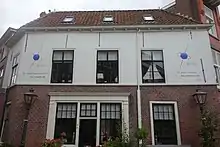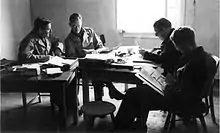Samuel Goudsmit
Samuel Abraham Goudsmit (July 11, 1902 – December 4, 1978) was a Dutch-American physicist famous for jointly proposing the concept of electron spin with George Eugene Uhlenbeck in 1925.[3][4]
Samuel Goudsmit | |
|---|---|
.jpg.webp) Samuel Goudsmit around 1928 | |
| Born | Samuel Abraham Goudsmit July 11, 1902 |
| Died | December 4, 1978 (aged 76) |
| Nationality | Dutch-American |
| Alma mater | University of Leiden (Ph.D) (1927) |
| Known for | |
| Spouses | |
| Children | |
| Awards | National Medal of Science (1976) |
| Scientific career | |
| Fields | Physics |
| Institutions | University of Michigan |
| Doctoral students | Robert Bacher |
Life and career
Goudsmit was born in The Hague, Netherlands, of Dutch Jewish descent. He was the son of Isaac Goudsmit, a manufacturer of water-closets, and Marianne Goudsmit-Gompers, who ran a millinery shop. In 1943, his parents were deported to a concentration camp by the German occupiers of the Netherlands and were murdered there.[5]

Goudsmit studied physics at the University of Leiden under Paul Ehrenfest,[6] where he obtained his PhD in 1927.[7] After receiving his PhD, Goudsmit served as a professor at the University of Michigan between 1927 and 1946. In 1930 he co-authored a text with Linus Pauling titled The Structure of Line Spectra.
During World War II he worked at the Massachusetts Institute of Technology.[8] As scientific head of the Alsos Mission, he successfully reached a German group of nuclear physicists around Werner Heisenberg and Otto Hahn at Hechingen (then French zone) in advance of French physicist Yves Rocard, who had previously succeeded in recruiting German scientists to come to France.

Alsos, part of the Manhattan Project, was designed to assess the progress of the Nazi atomic bomb project. In the book Alsos, published in 1947, Goudsmit concludes that the Germans did not get close to creating a weapon. He attributed this to the inability of science to function under a totalitarian state and to Nazi scientists' lack of understanding of how to engineer an atomic bomb. Both of these conclusions have been disputed by later historians (see Heisenberg) and contradicted by the fact that the totalitarian Soviet state produced the bomb shortly after the book's release.[9]. However that statement overlooks the actions of physicist Klaus Fuchs who sent "many intelligence reports directly from Los Alamos". Read the book American Prometheus (2006), pages 285-286 by authors Kai Bird & Martin Sherwin.

After the war he was briefly a professor at Northwestern University, and from 1948 to 1970 was a senior scientist at the Brookhaven National Laboratory, chairing the Physics Department 1952–1960. He meanwhile became well known as editor-in-chief of the leading physics journal Physical Review, published by the American Physical Society. In July 1958 he started the journal Physical Review Letters,[10] which offers short notes with attendant brief delays.[11] On his retirement as editor in 1974, Goudsmit moved to the faculty of the University of Nevada in Reno, where he remained until his death four years later.
He also made some scholarly contributions to Egyptology published in Expedition, Summer 1972, pp. 13–16 ; American Journal of Archaeology 78, 1974 p. 78; and Journal of Near Eastern Studies 40, 1981 pp. 43–46. The Samuel A. Goudsmit Collection of Egyptian Antiquities resides at the Kelsey Museum of Archaeology at the University of Michigan in Ann Arbor, Michigan.[12]
Goudsmit became a corresponding member of the Royal Netherlands Academy of Arts and Sciences in 1939, though he resigned the next year. He was readmitted in 1950.[13] He was elected to the United States National Academy of Sciences in 1947,[14] the American Philosophical Society in 1952,[15] American Academy of Arts and Sciences in 1964.[16]
Marriages and children
Goudsmit married Jaantje Logher, in 1927.[2] Their daughter, Esther Marianne Goudsmit was born in 1933 in Ann Arbor, MI. In 1964 she earned a Ph.D in Zoology from the Univercity of Michigan, and in 1972 became a Professor of Biology at Oakland University, Rochester, MI. She retired in 1995.
Samual and Jaantje divorced in 1960, and in the same year Goudsmit married Irene Bejach.[1][2] Like Goudsmit's parents, Irene's father, a German medical doctor and Berlin public health official, Curt Dietrich Bejach, had been murdered by the Nazis. He perished at the Auschwitz concentration camp.[17][18]
Irene and her sister, Helga, left Germany for the United Kingdom as children shortly prior to the outbreak of World War II. They were evacuated as part of the Kindertransport programme, and lived for seven years in the Attenborough family home.[18]
Works
- Goudsmit, Samuel A. (1947). Alsos.
- Goudsmit, Samuel A.; Claiborne, Robert (1966). Time. Time-Life Science Library. New York, Time.
- Goudsmit, S.; Saunderson, J. L. (1940). "Multiple Scattering of Electrons". Phys. Rev. 57 (1): 24–29. Bibcode:1940PhRv...57...24G. doi:10.1103/physrev.57.24.
References
- "Biography of Document Creator Samuel Abraham Goudsmit, Samuel and Irene Goudsmit Collection, United States Holocaust Memorial Museum (Document Accession Number: 1995.A.0300 Duplicate 1, RG Number: RG-10.228". USHMM.org. United States Holocaust Memorial Museum. Archived from the original on 4 July 2021. Retrieved 4 July 2021.
- "Goudsmit, Samuel A. (Samuel Abraham), 1902-1978". AIP.org. American Institute of Physics, Physics History Network. Archived from the original on 26 January 2021. Retrieved 4 July 2021.
- G.E. Uhlenbeck and S. Goudsmit, Naturwissenschaften 13(47) (1925) 953.
- Goldhaber, Maurice (April 1979). "Obituary: Samuel A. Goudsmit". Physics Today. 32 (4): 71–72. Bibcode:1979PhT....32d..71G. doi:10.1063/1.2995511.
- Benjamin Bederson, 2008, Samuel Abraham Goudsmit 1902 — 1978, Biographical Memoir, National Academy of Sciences, Washington D.C.
- Samuel Goudsmit at the Mathematics Genealogy Project
- Samuel Goudsmit (1927). "Atoommodel en structuur der spectra" (PDF).
- Asimov. Asimov's Biographical Encyclopedia of Science and Technology (2nd revised ed.).
- Koeth, Tim (May 2019). "Tracking the journey of a uranium cube". Physics Today. 72 (5): 36–43. Bibcode:2019PhT....72e..36K. doi:10.1063/PT.3.4202.
- "Samuel A. Goudsmit Papers, 1921-1979". Archived from the original on October 31, 2014. Retrieved October 31, 2014.
- The Laser Inventor. Springer Biographies. 2018. doi:10.1007/978-3-319-61940-8. ISBN 978-3-319-61939-2.
- Description of Goudsmit's contribution to the museum, cdli.ucla.edu. Accessed September 5, 2022.
- "S.A. Goudsmit (1902 - 1978)". Royal Netherlands Academy of Arts and Sciences. Retrieved 24 January 2016.
- "Samuel Goudsmit". www.nasonline.org. Retrieved 2023-02-08.
- "APS Member History". search.amphilsoc.org. Retrieved 2023-02-08.
- "Samuel Abraham Goudsmit". American Academy of Arts & Sciences. Retrieved 2023-02-08.
- "Biographical Note, Curt Bejach Collection, Leo Baeck Institute, Center for Jewish History (Collection Identifier: AR 10876)". CJH.org. Leo Baeck Institute, Center for Jewish History. Archived from the original on 27 October 2020. Retrieved 4 July 2021.
- Wolfisz, Francine (3 December 2020). "'We are one family': Sir David Attenborough recalls Jewish refugee 'sisters'". Jewish News. London, United Kingdom: Jewish News, The Times of Israel. Archived from the original on 26 January 2021. Retrieved 4 July 2021.
External links
- Annotated Bibliography for Samuel Abraham Goudsmit from the Alsos Digital Library for Nuclear Issues
- Goudsmit on the discovery of electron spin
- A collection of digitized materials related to Goudsmit's and Linus Pauling's structural chemistry research.
- National Academy of Sciences Biographical Memoir
Archival collections
- Samuel A. Goudsmit papers, 1921-1979, Niels Bohr Library & Archives
- Esther Marianne Goudsmit papers, 1927-1981, Niels Bohr Library & Archives (includes correspondence from Samuel Goudsmit during and after his involvement with the Alsos Mission following World War II)